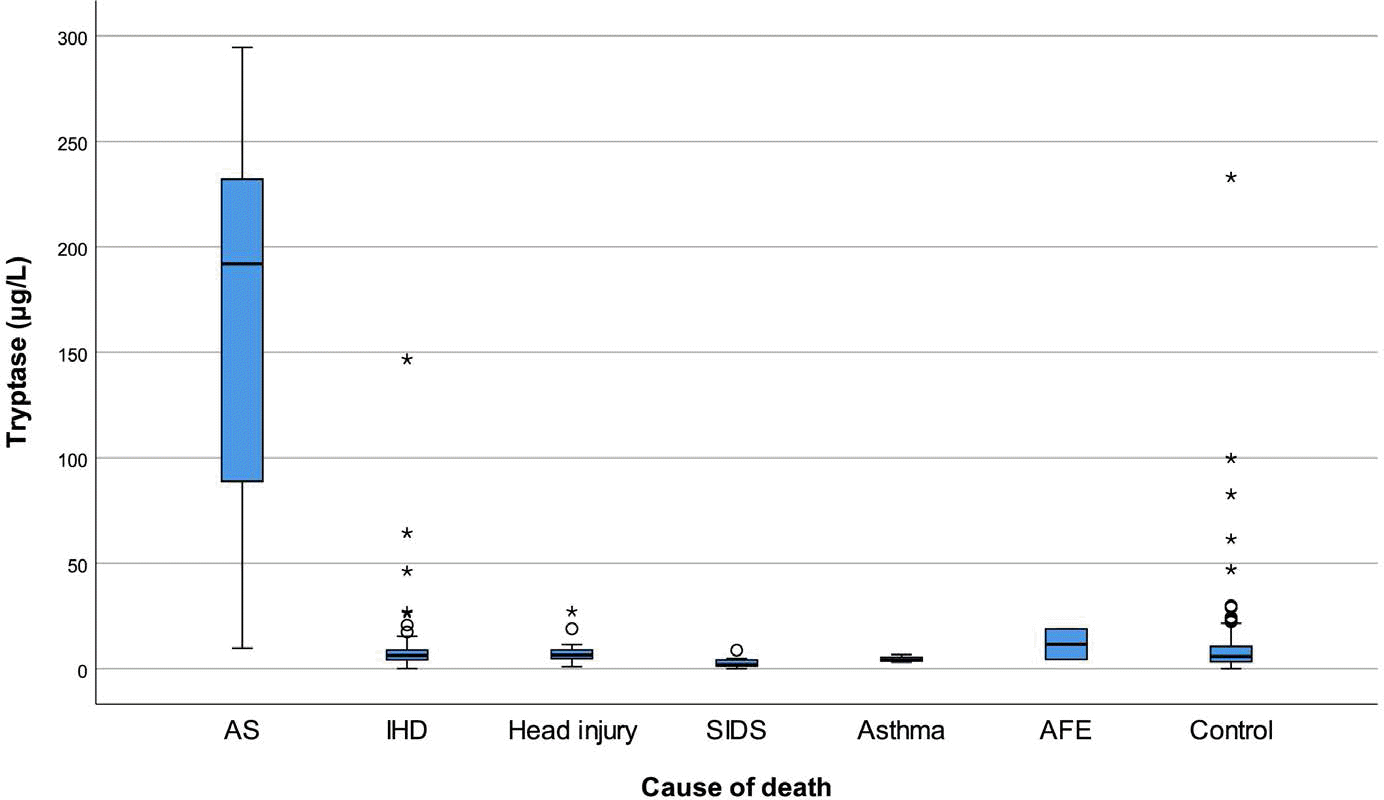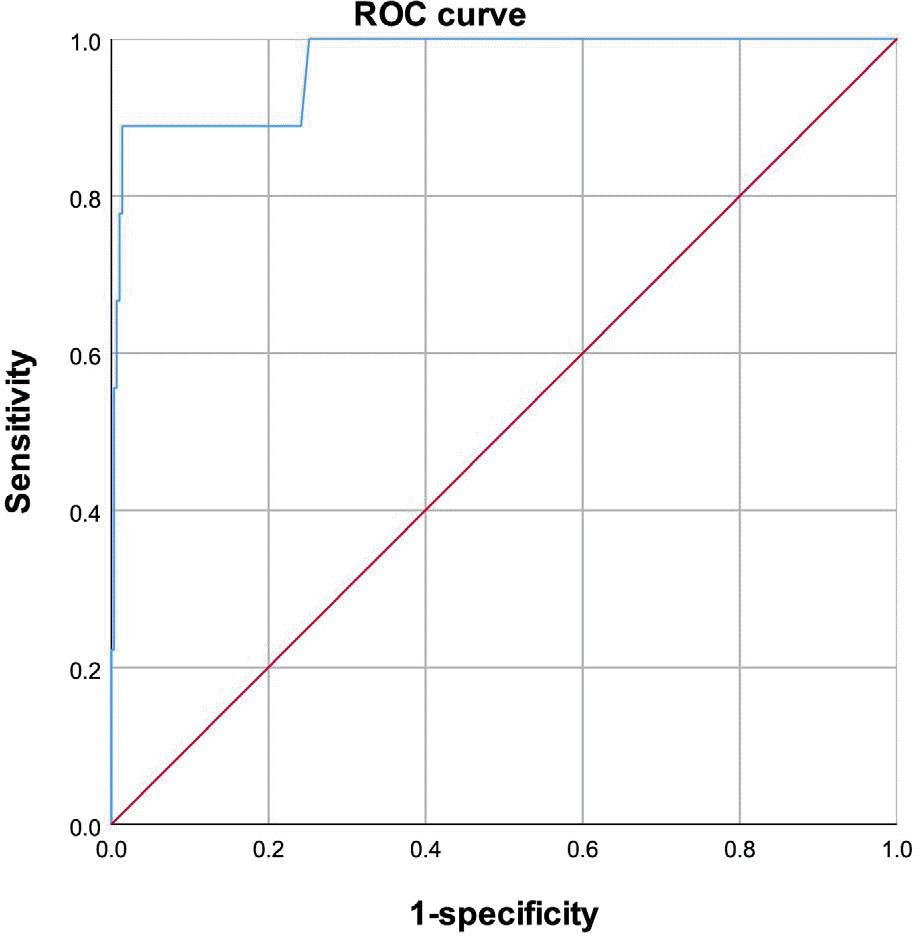Abstract
Anaphylactic shock (AS) is a systemic and life-threatening type I hypersensitivity reaction and is often encountered at an autopsy. However, postmortem diagnosis of AS can be difficult due to non-specific autopsy findings. Clinically, the analysis of serum mast cell tryptase (MCT) is well known as a useful ancillary test for the diagnosis of AS. However, in order to apply this test to forensic autopsy, it is necessary to confirm its usefulness due to postmortem changes. We carried out serum MCT analysis in 299 autopsy cases including nine AS cases at National Forensic Service from January 2013 to May 2015 and analyzed the difference according to the cause of death and degree of postmortem change. As a result, the MCT level in AS was significantly increased compared to others, and the appropriate cutoff value for postmortem diagnosis of AS was 63.0 μg/L (sensitivity 88.9%, specificity 98.6%). Conclusively, serum MCT analysis is a useful test for postmortem diagnosis of AS and seems to be more appropriate for screening rather than confirmation.
Go to : 
REFERENCES
1. Rutkowski K, Dua S, Nasser S. Anaphylaxis: current state of knowledge for the modern physician. Postgrad Med J. 2012; 88:458–64.

2. Da Broi U, Moreschi C. Postmortem diagnosis of anaphylaxis: a difficult task in forensic medicine. Forensic Sci Int. 2011; 204:1–5.

3. Byard RW. An analysis of possible mechanisms of unexpected death occurring in hydatid disease (echinococcosis). J Forensic Sci. 2009; 54:919–22.

4. Nara A, Aki T, Funakoshi T, et al. Death due to blood transfusion-induced anaphylactic shock: a case report. Leg Med (Tokyo). 2010; 12:148–50.

5. Belton AL, Chira T. Fatal anaphylactic reaction to hair dye. Am J Forensic Med Pathol. 1997; 18:290–2.

6. Pumphrey RS, Roberts IS. Postmortem findings after fatal anaphylactic reactions. J Clin Pathol. 2000; 53:273–6.

7. Beck SC, Wilding T, Buka RJ, et al. Biomarkers in human anaphylaxis: a critical appraisal of current evidence and perspectives. Front Immunol. 2019; 10:494.

8. Edston E, van Hage-Hamsten M. beta-Tryptase measurements postmortem in anaphylactic deaths and in controls. Forensic Sci Int. 1998; 93:135–42.
9. Mayer DE, Krauskopf A, Hemmer W, et al. Usefulness of post mortem determination of serum tryptase, histamine and diamine oxidase in the diagnosis of fatal anaphylaxis. Forensic Sci Int. 2011; 212:96–101.

10. Scarpelli MP, Keller S, Tran L, et al. Postmortem serum levels of IgE and mast cell tryptase in fatal asthma. Forensic Sci Int. 2016; 269:113–8.

11. Tamura N, Farhana M, Oda T, et al. Amniotic fluid embolism: pathophysiology from the perspective of pathology. J Obstet Gynaecol Res. 2017; 43:627–32.

12. Xiao N, Li DR, Wang Q, et al. Postmortem serum tryptase levels with special regard to acute cardiac deaths. J Forensic Sci. 2017; 62:1336–8.

Go to : 
 | Fig. 1.Comparison of mast cell tryptase level among groups according to cause of death. AS, anaphylactic shock; IHD, ischemic heart disease; SIDS, sudden infant death syndrome; AFE, amniotic fluid embolism. |
 | Fig. 2.Receiver operating characteristic (ROC) curve for mast cell tryptase levels to diagnose anaphylactic shock. |
Table 1.
Anaphylactic shock cases
Table 2.
Comparison between peripheral blood and heart blood on the mast cell tryptase concentration
| P/H | No. (%) |
|---|---|
| <0.25 | 5 (3.8) |
| 0.25-0.5 | 14 (10.5) |
| 0.5-1.0 | 29 (21.8) |
| 1.0-2.0 | 61 (45.9) |
| 2.0-4.0 | 21 (15.8) |
| >4.0 | 3 (2.2) |
| Total | 133 |
Table 3.
Comparison of mast cell tryptase level among groups according to COD
| COD | No. | Mean±SD (μg/L) | Median (IQR) (μg/L) | Range (μg/L) | P-value a) |
|---|---|---|---|---|---|
| AS | 9 | 164.0±98.2 | 191.9 (169.0) | 9.8-294.5 | |
| IHD | 76 | 10.3±18.4 | 6.4 (4.7) | 0.1-146.7 | |
| Head injury | 22 | 7.9±5.7 | 6.6 (4.5) | 1.0-27.2 | |
| SIDS | 9 | 2.9±2.7 | 2.0 (3.7) | 0.0-8.8 | <0.001 |
| Asthma | 3 | 4.7±1.9 | 4.1 | 3.1-6.8 | |
| AFE | 2 | 11.7±10.3 | 11.7 | 4.4-18.9 | |
| Control | 178 | 10.4±20.5 | 5.9 (7.5) | 0.0-233.0 |
Table 4.
Analysis of variables affecting on postmortem mast cell tryptase concentration
| Variable | No. | Value | P-value |
|---|---|---|---|
| Sex | Median (IQR) (μg/L) | ||
| Male | 208 | 6.15 (6.20) | 0.796 |
| Female | 82 | 5.85 (6.53) | |
| Correlation coefficient | |||
| Age | 289 | 0.102 | 0.085 |
| PMI | 266 | 0.094 | 0.127 |
| K+ | 171 | 0.158 | 0.039 |
Table 5.
Sensitivity and specificity of postmortem mast cell tryptase anlysis for anaphylactic shock diagnosis
Table 6.
False-positive cases




 PDF
PDF ePub
ePub Citation
Citation Print
Print


 XML Download
XML Download